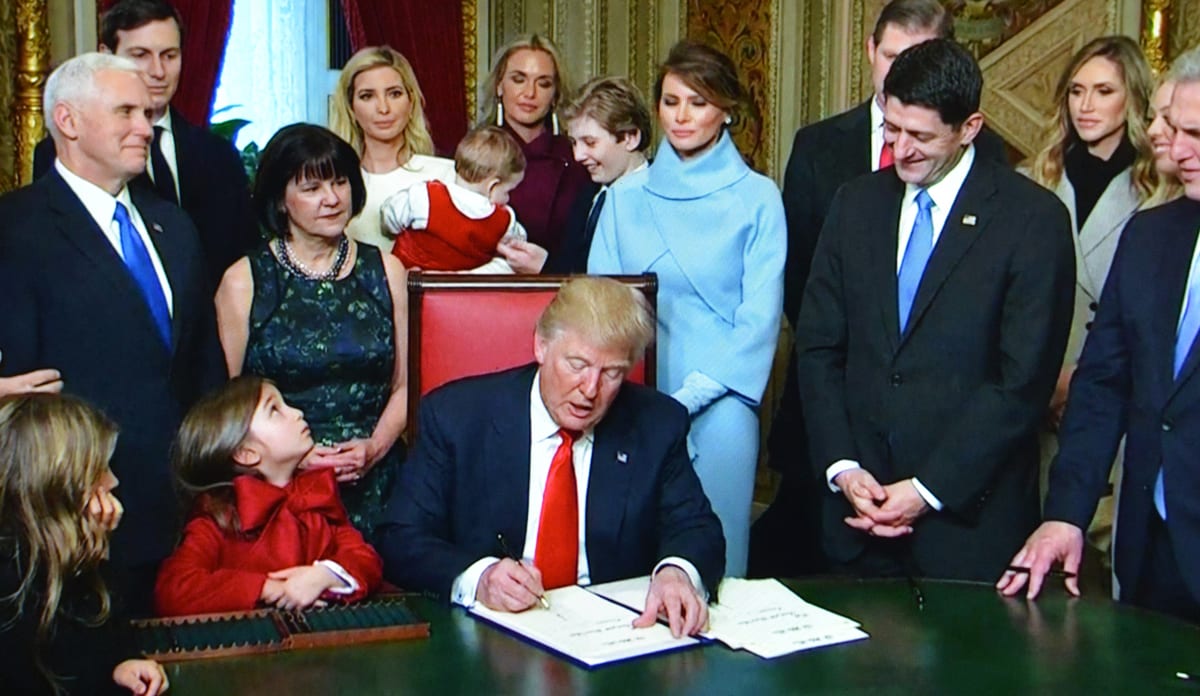Dear Readers,
We’re either headed for modern civilization’s biggest economic and financial disaster, or we’re headed for a record-breaking period of growth and positive change.
In my final Letter for 2017, I’ll walk you through how I plan to traverse the abyss and where I’ll be putting my money in 2018.
An Investor’s Dream
The average business cycle is around six years; the average stock market cycle around seven.
We’re now heading into the 10th year of a bull market (minus a couple of dips in between).
The global economy is growing and for the first time since 2010, the world economy is outperforming most predictions.
Global stock volatility is lower than ever. In fact, one percent swings in either direction in the MSCI All-Country World Index happened only 3 times this year (May, April, August). It never climbed above two percent.
Meanwhile, positive factors continue driving the market forward. Rates remain at near all-time lows, unemployment is shrinking, and wages are trending higher.
Furthermore, the efficiency of corporations (through cutbacks etc.), combined with cheap energy and cheap money, have led to stronger earnings, with S&P 500 companies operating earnings averaging 20%.
These positive fundamentals have driven the market to new all-time highs with valuations far exceeding historic multipliers.
Take Nvidia, for example.
At the peak of the dot-com boom, Nvidia traded around seven to eight times revenue, with revenue growing 100% year-over-year. Today, revenue growth is around 31.5% year-over-year, according to its recent Q3. Yet, it currently trades at around 15 times revenue.
That means Nvidia is now trading at nearly twice its dot-com boom valuation, yet it has three times less revenue growth.
Could our markets be that much more overvalued today than it was in the dot-com boom, or is something else driving that valuation?
In just a bit, I’ll tell you the secret behind Nvidia’s valuation and why it’s a precursor to one of the most powerful changes to our economy.
Highest Valuations on Record
 Companies across the board are reaching historic high valuations. That’s our market today.
Companies across the board are reaching historic high valuations. That’s our market today.
Even the private markets are booming.
According to Pitchbook, Middle Market (US-based companies acquired through buyout transactions between US$25 million and $1 billion) multiples have reached the highest level on record.
Via Pitchbook:
“Due to the abundance of dry powder and fierce competition for limited targets, median mid-market M&A EBITDA multiples have risen to their highest level on record-10.7x through 3Q 2017.”
Startup valuations are also at record highs hitting their highest point on record this year:
- Seed-stage: $6.2 million
- Early-stage: $20 million
- Late-stage: $65 million
This frothy enthusiasm is now spreading across all markets, with retail investors finally pouring in after a long 9 years of an institutionally and corporately supported market.
Retail is Back
Despite having been fined hundreds of millions in the past year for misusing investor money, the cash balance of BofA Merril Lynch is now at the lowest it has been since 2007.
According to BofA Merril Lynch:
“Global funds are showing signs of “irrational exuberance”, with cash holdings at four-year lows and risk-taking at all-time highs, Bank of America Merrill Lynch’s monthly investor survey said on Tuesday.”
And these retail investors are putting their cash to work.
According to Q3 earnings, Charles Schwab saw new brokerage account openings up 29% year-over-year.
To put that into perspective, new accounts are at levels not seen since the dot-com boom of the late 1990s.
In the first half of the year, Schwab clients opened 719,000 new brokerage accounts. That’s the biggest first-half increase in 17 years! They opened another 216,000 in Q3.
All of this means the retail crowd is once again excited about investing.
In fact, retail investors attracted 51% more inflows than a year ago.
Via Charles Schwab:
“Retail attracted 51% more inflows than a year ago, and the assets brought in by the independent advisor clients who custody with us rose 68%.
In just nine months we’ve generated $136.7 billion in core net new assets – enough to surpass all but one of our prior full-year results.
Our growing client base continues to make greater use of our modern wealth management capabilities: assets receiving ongoing advisory services grew 18% from the third quarter of 2016 to a record $1.61 trillion at month-end September. Total client assets reached a record $3.18 trillion, up 17% year-over-year.”
Record inflows of capital are happening across many markets, with US-listed ETFs attracting a record $473.9 billion in net inflows this year.
That’s nearly half a trillion dollars poured into US ETFs alone!
And according to LPL Financial, the relative strength index (RSI), an indicator of technical momentum, is at its highest level since 1995 – which means the S&P 500 is at its most overbought level in 22 years.
But with all this optimism, is there any fuel left for 2018?
According to historical patterns, yes.
Via Marketwatch:
“Somewhat surprisingly, the future returns are actually stronger after such periods of overbought natures,” Lynch wrote.
“For instance, a year after being overbought, the S&P 500 is up 12.8% on average versus the average gain of 8.8% and higher 12 out of 13 times, which suggests there may be a good chance for solid market returns next year.”
Furthermore, despite cash balances being at four-year lows, investors still have more money to pour into the market.
According to BofA Merryl Lynch, “The all-time low for global cash balances was 3.4 percent in July 2007 and it has often troughed out below 4 percent, suggesting risk appetite has not maxed out.”
And of course, let’s not forget about the rise of Bitcoin and other cryptocurrencies. These kinds of speculative booms simply don’t happen when investors are fearful.
In other words, barring unforeseen economic or political shocks, we could be in store for a much better than expected 2018.
But there’s more.
Unleash the Corporate Cash
2017 marked another year where companies held record amounts of cash.
Over the past few years, these companies have been reluctant to invest in capital expenditures.
But moving into 2018, I believe many of these companies will begin to unleash some of this cash and invest in areas such as new production processes, new technologies, IT, and digital security.
I believe they have no choice.
The resulting rapid growth in technology will force disruption across many sectors, forcing many new acquisitions and mergers. If companies don’t invest now in new technologies and processes, they will be eaten alive by those who do.
Thank You, President Trump

The investment in capital expenditures will be further fueled by the repatriation tax holiday for US companies brought on by the Trump Administration, in which US companies could bring back hundreds of millions of dollars to avoid paying higher taxes in the future.
According to Goldman Sachs, S&P 500 companies hold US$920 billion in untaxed overseas cash, and it estimates that $250 billion of that would be repatriated.
But that’s just the beginning.
According to Citigroup, US-based companies have a whopping $2.5 trillion of capital stashed internationally.
The bulk of this money belongs to companies heavily concentrated in the tech and healthcare sectors and includes big names such as Cisco, Apple, GE, Qualcomm, Amgen, and Oracle.
Some of this money will come back to the US, and it will force one of two likely outcomes:
- Corporate share buybacks
- Capital expenditures/reinvestment
My guess is the latter will be the more likely outcome given the incentives by policymakers. Furthermore, with record-high valuations, it would make more sense for corporations to spend on CapEx and acquisitions rather than the buyback of shares – especially since high share prices are often the best currency for buyouts.
Last year, I predicted we would continue to see significant activity for mergers and acquisitions (M&A) in 2017, just as we did in 2016.
According to preliminary Thomson Reuters data, unsolicited takeovers helped push global M&A to US$3.54 trillion in 2017.
The peak M&A year since 2008 was 2015 when M&A totaled US$4.22 trillion.
I suspect that in 2018, there’s a strong chance we could reach or even breach the 2008-peak.
That means small-to-mid cap stocks could see significant appreciation as M&A picks up and as investors fight for shares in those they believe will be acquisition targets.
Furthermore, under the Trump Administration, US regulators are expected to further ease regulation to speed up the approval process for new drugs. This could also bring about further M&A as smaller drugmakers and others become targets.
So how should we take advantage of this?
Passing the Torch
2018 marks an important year for our next generation.
And that’s the key: the Next Generation.

The torch is being passed from the Baby Boomers to the Millennials.
Millennials will become the decisive force driving our economy through interaction across economic, technological, social, and political realms. As digital natives who are global and interconnected, they have different views and approaches to banking and investing, different views of energy, and different expectations and priorities both from a social and political perspective.
They will soon become the dominant generation of active workers, and as such, will be the focus of politicians and corporations moving forward.
If it weren’t for the politically correct and Liberal nature of Millennials, Trudeau may have never been voted in as Canada’s PM.
If it weren’t for Millennials, Amazon may not have become one of the biggest retailers in the world.
From corporate buy-outs that cater to Millennial consumer startups to the new era of clean energy brought on by Millennials who demand it, the shift in corporate focus is targeted directly at the Next Generation.
That means the biggest growth sectors and developments will be aimed at Millennials and their plans for an on-demand, connected, and automated future.
They will be the drivers of new investment trends and ideas.
They are the ones who will drive share prices higher.
Where and How to Invest in 2018
Commodities
 Commodities will always have its place. But for 2018, the focus isn’t simply on the raw materials driving the market forward.
Commodities will always have its place. But for 2018, the focus isn’t simply on the raw materials driving the market forward.
No, it’s on the next era of sustainability: The Millennial era.
As prime land grows increasingly expensive alongside the rising costs of living, a focus on urban living technologies is paramount.
This can be seen in Vertical Farming technologies that bring large-scale agriculture to cities, using techniques such as vertically stacked layers, indoor farming, and integration of agriculture into existing structures.
Technologies that facilitate these processes, such as technologies that lower input costs through energy and water savings, will be winners in this area.
But the biggest shocker within this sector is the new and up-coming subcategory…
Sustainable Consumables

Millennials are growing increasingly protective of the environment and our planet.
According to the United Nations and the Food & Agriculture Organization (FAO), the primary cause of species extinction, Amazon deforestation, oceanic dead zones and antibiotic resistance, is raising animals for food.
In fact, raising animals for food has an even greater impact on climate change than the entire transport sector (sorry, Mr. Elon Musk.)
According to FAO, the demand for meat is expected to double by 2050, but our current and inefficient system of animal agriculture won’t be able to meet that demand – not without serious damage to our ecosystem.
As a result, we’re already witnessing disruptive technologies emerge to combat the growing inefficiencies of food production.
This includes both plant-based food (think Soy) and cellular agriculture (think lab-grown meat).
Investment opportunities in the private sector are abundant and we’ll likely see early public participation in 2018.
Meat-alternative and “clean meat” (lab-grown meat) technologies are already receiving massive inflows of capital via major investments from meat producers.
It may sound crazy at first, but it’s expected that clean meat will eventually become an industry worth US$700 billion.
Here’s an article from earlier this year we wrote on the rise of “clean meat”: Your Next Steak Could Come from a Test Tube
Energy Efficiency/Green Tech

How can we talk about efficiency without talking about energy?
We’re going to witness a dramatic shift in 2018 as a record number of electric vehicles (EV) will be put on the road, followed by an even bigger production line in the coming years.
That means supplies required to build EV’s will be in demand, and the materials (such as lithium and cobalt) and the companies that produce them will continue to soar in 2018.
But it’s not only the obvious that will make headlines.
Energy efficiency technologies will span across all sectors, with electric engines and other energy protocols taking over existing technologies.
For example, the rise of the Internet of Things technologies and improved sensors will continue to reduce upfront capital expenditure costs, with monitoring technologies that are steadily improving how companies manage their energy efficiencies in the production process.
And since the complete retrofit and upgrades of these motor-based energy systems generally has a short payback period of around 12 to 18 months, look for many companies to begin the transition.
As a result, investment opportunities into emerging energy efficiency technologies will open up and gain more traction.
This includes everything from more efficient motors capable of cost savings throughout numerous sectors, and even new business models where companies sell units of power such as horsepower or cubic meters of air instead of engines and air compressors.
Again, these are the demands of the Millennials.
Bionics/Applied Genetics
 The market appeal for bionics and applied genetics will grow in 2018.
The market appeal for bionics and applied genetics will grow in 2018.
We are beginning to truly understand both our genetic makeup and how to modify and edit our genomes. Think CRISPR (Clustered Regularly Interspaced Short Palindromic Repeats), a well-known and advanced genome editing technology.
Imagine being able to remove malaria from mosquitos, eliminate cancer, make super plants, treat blindness, and even create designer babies born with black hair and orange eyes. It may sound farfetched, but these are all possible with CRISPR and genome editing technologies.
The ability to modify genomes will undoubtedly lead to novel therapies in medicine and will be applied across numerous industries including agriculture and even energy.
While still in the early stages, the rapid deployment of capital into these studies could propel a new era of biotechnologies in the later stages of 2018.
In fact, it is expected that in 2018, the first human is going to get dosed with CRISPR in the clinic.
Early and patient investors in this sector could reap significant rewards.
Security and Cybersecurity

This one speaks for itself.
The on-going threats internationally combined with terrorist attacks on home soil will continue to force advancements in security. Everything from drones and military tech will see significant capital inflows.
Furthermore, we witnessed many major security breaches in 2017 – the Equifax breach, the Verizon breach, the NSA breach, the Uber breach, state-sponsored cyber attacks, and even the Russian manipulation of social media.
Don’t expect 2018 to be any easier.
Hackers have new tools and are becoming smarter, while security teams and budgets won’t be able to keep up.
In fact, surveys show that US companies subject to the European Union’s General Data Protection Regulation (GDPR) are far behind where they need to be to make the May 25, 2018 compliance deadline.
Investments into this category could be very rewarding, especially as the Internet of Things and connected devices push forward.
Tech and Vertical Disruptions
 2018 will continue to be a year for technological and vertical disruption.
2018 will continue to be a year for technological and vertical disruption.
The shift from brick-and-mortar to online and mobile businesses will continue. We’ll begin to see more retail outlets crumble away, as they get eaten by the efficiencies of online businesses. This includes everything from retailers to banks and many other verticals.
Automation will begin taking over and almost every vertical will experience major disruptive changes.
For example, the camera industry will witness an immense boom, but not for the reasons you may think.
It used to be that cameras existed to display things to humans. But that’s about to change in a big way. The rise of machine-learning is allowing computers to recognize and label images, while self-driving cars are using cameras to sense their surroundings.
In other words, while cameras in smartphones will continue to dominate, we’re about to witness a major boom in the camera market as they go into machines everywhere, from security and surveillance, to robotics and self-driving cars.
Obviously, this is one of the reasons why we’re super excited about one of the lens companies in our current portfolio (more updates on this Company in the coming months).
Furthermore, one of the most liquid public markets in the world, the Hong Kong exchange, will begin allowing pre-revenue tech and healthcare companies to go public in the second half of 2018, which means a lot more money will pour into those sectors.
Via SCMP:
“Under the HKSE’s new rules effective in mid-2018, biotech firms need at least HK$1.5 billion in valuation at the time of their listing, but they need not have any revenue track record to raise funds in the city.
Companies with multiple classes of shares must be engaged in businesses classified as new economy, with at least HK$10 billion in valuation and annual revenue of at least HK$1 billion. Businesses with valuations exceeding HK$40 billion (US$5.1 billion) can raise funds in Hong Kong with a lower revenue threshold, according to the new rules.”
It’s clear that 2018 will be a big year for the advancement of technologies dedicated to Millennials. But by far the easiest and most profitable sectors to invest in, mainly because of how mainstream they will become, are the following three…
The Three Biggest Trends
1. Marijuana

With legalization happening all around the world, 2018 will mark the biggest year for the marijuana space.
In Canada, full legalization is expected to occur and there’s no doubt in my mind that it will propel shares of marijuana stocks even higher than today.
In the US, California begins legalization tomorrow. That means a market that’s even bigger than Canada is about to open up. It remains difficult for investors to participate in this market due to federal laws, but we’ll likely see many Canadian companies enter the market.
As the hype grows within both the Canadian and US market, the international market will begin to light on fire also.
It’s going to be an insane year for this cash cow sector that will soon become a global phenomenon.
So regardless of your views on marijuana, if you miss this opportunity, you will most certainly kick yourself.
I am already heavily invested in this sector and plan on investing even more.
2. Blockchain/Cryptocurrencies

This one is obvious and needs no introduction.
2017 was an insane year for the rise of cryptocurrencies and the launch of Block Chain
decentralized services.
Earlier this year, I wrote about how Bitcoin could be the answer for the already inflated balance sheets of central banks and suggested that it, and other cryptocurrencies, are either being used as the next wave of economic stimulus, or the test-run/scapegoat for governments to begin the implementation of their own digital currencies.
While I warn many to make sure they know precisely what they are investing in before they do, there will be plenty of opportunities within these spaces that will make millionaires out of the average and billionaires out of millionaires.
2018 promises to finally bring the hype of decentralized services to the market. This will affect many sectors including investment banking, stock trading platforms, insurance and even utilities by giving these industries the ability to offer real-time settlements and smart contracts.
In the new age of connected homes, self-driving cars, and automated systems, the idea of enabling machines to transact in real-time through a centralized blockchain network will have a profound impact on almost every aspect of life.
Investments in the sector should be focused on the security and advancements in scalability for these block chains, as the Block Chain technology will also provide machine-to-machine transaction networks.
The rise of Bitcoin and Blockchain could be even bigger than the dot-com boom. In other words, lots of money will be made. And lots of money will be lost.
However, consider one important thing: most people speak of the dot-com bubble in a negative light, but today, almost every business is either a dot-com business or at least has a dot-com footprint. In fact, the biggest companies in the world today are dot-coms. Think Google, Facebook, and Amazon.
In other words, Blockchain companies will come and go but the technology is here to stay, and it will impact almost every business in the future.
But if we really want to talk about the biggest impact on our future, there is one sector that trumps them all.
3. The Biggest of All: Artificial Intelligence/Robotics

Earlier in this Letter, I talked about Nvidia’s valuation and how it’s trading at twice the valuation of its dot-com peak despite having three times less revenue growth.
The primary reason? It’s entry into artificial intelligence and machine learning.
There’s no doubt that Artificial Intelligence (AI) will be the single biggest disruption to not only our markets in 2018 but to humanity itself.
The amazing and rapid advancements in high-performance computing and big data are now at the breaking point where intelligent machines and algorithms can solve problems that previously could only be solved by humans.
And every day, 24/7, these machines are learning at an increasingly faster pace.
This rapid advancement in AI will allow technologies to flourish like never before, which means that AI will soon become a mainstream topic both from a technological and moral perspective.
Will AI displace our jobs? Will AI create the ultimate Big Brother surveillance state? Will AI rule our future?
The scary answer is yes, yes, and yes.
While climate change will affect us in 50-100 years, AI will significantly change our world in much less time.
Consider Moore’s Law, where Intel co-founder Gordon Moore stated that the number of transistors in an integrated circuit would double every two years. In other words, he predicted that the processing power of computers will double every two years. And this has proven true over the past decades.
It takes only 40 doubles to equal a trillion.
Since 1965, when Moore’s Law was introduced, we have essentially experienced a trillion-fold increase in computing power.
Via Experts-Exchange:
“We may (sadly) live in a world devoid of flying cars and personal teleportation devices, but that doesn’t mean technology isn’t moving forward at an incredible pace. We compared the processing power for various computers and devices from 1956 to 2015 to visualize the 1 trillion-fold increase in performance over those six decades. By comparing each processor’s floating operations per second (FLOPS), we avoided any differences in microarchitectures.”
What will happen in the next 40 years?
What would happen if our current computing power increases not one, ten, or even a hundred times, but a trillion?!?!
Algorithms are getting better and data, a requirement for successful AI, is getting bigger. Combine them with the exponential growth in computing power and computers could soon take over many aspects of life.
The only way to survive in the coming age of artificial intelligence is to invest and own them early.
Or they will end up owning you.
Not All Rose-Coloured Glasses
Despite the positive sentiment surrounding the global economy, I can’t help but feel the eerie blanket of calm draped over the markets.
One could say it’s the feeling of calm before the storm.
From the Fed raising rates to political instability in the US, Europe, and the Middle East, we still have a lot of headwinds facing the global economy in 2018.
The Federal Reserve is expected to continue raising rates gradually in 2018 and beyond, while slowly reducing its US$4.5 trillion balance sheet.
Meanwhile, the European Central Bank will focus on tapering asset purchases.
Then there’s the March election outcome in Italy, the renewed rise of tensions in Spain, and the potential for a hard Brexit.
Let’s not forget that a trade war between the US and China could erupt, while the cancellation of NAFTA under Trump without a replacement could severely impact growth and risk assets, especially in emerging markets.
There’s also the potential credit bubble burst in China, which could affect the entire world.
Economics aside, world conflicts continue to intensify with North Korean threats escalating and armed conflicts in the Middle East brewing, both of which could affect commodities and oil and gas prices.
Furthermore, a large-scale terrorist attack isn’t out of the question and remains a top priority for the US. Keep in mind that these terrorist attacks could come in all forms, from all angles, including a global disruption via a massive cyber attack that would have far-reaching repercussions for financial markets.
Conclusion
Going into the tenth year of a bull market is certainly not without its risks. But right now, missing the run could prove very risky.
After living through both the dot-com bubble and the 2008 financial crisis, many Baby Boomers have left the market. This led to an investment market dominated by institutions, funds, and algo-traders.
However, with the rise of robo-advisors, simplified online trading, and new sectors that appeal to Millennials, Millennials now look to be the driving force behind the retail market – opening new accounts and pouring money into stocks.
The Next Generation is on a path toward the era of artificial intelligence, big data, and cloud platforms, which are further being powered by connected devices and decentralized networks. These ultra-efficient innovations will create significant opportunities for the smaller, more nimble firms to truly deliver bespoke products and services for the next generation.

Most importantly, unlike most of the past century that was dominated by a human labour force, this next generation will be dominated by machine learning robots and computers that can work and learn 24/7 without rest.
The US used to be 60% of the global economy. Today, its barely over 25%. If the US doesn’t do something quick, the dollar will become even less relevant moving forward – significantly impacting the global balance of power.
Under the Trump Administration, bringing production back to the US makes sense – especially if US companies can invest in machines that will be cost competitive with overseas labour markets.
I suspect there will be even larger incentives for US companies to bring back not only capital but also increase their CapEx spending natively.
This should bode very well for the small-to-mid cap market whose ability to be nimble means significant advances in technologies, and more importantly for us investors, share appreciation.
There will be a lot of investment ideas next year. As such, in addition to our special reports that feature our biggest investments, we’ll be adding new ideas in a sub-section of our website to address the growing choices for investment ideas. These niche ideas won’t be sent via the monthly newsletter but will be posted on our website – so be sure to check out www.equedia.com more often.
I want to close this Letter and the year by thanking all of you for your continued readership and support. We’ve had yet another great year, with our two new featured companies up significantly on the year.
Emerging sectors such as blockchain and marijuana have renewed the interest for investing in stocks. I am witnessing people that have never invested in their lives turn into regular traders.
That’s a sign of a true bull market.
If this continues in 2018, it could be a life-changing investment year for many.
My personal plan is to cash-in on 2018 and cash-out before the market collapses.
Hopefully, I will time this right and be sitting on a pile of cash to pick up the pieces in the aftermath.
Have a Happy New Year and a fruitful 2018.
Seek the truth and until next year,
Ivan Lo
The Equedia Letter
www.equedia.com
Disclosure:
We’re invested and plan on investing in many of the sectors mentioned in this Letter. Equedia.com and Equedia Network Corporation are not registered as investment advisers, broker-dealers or other securities professionals with any financial or securities regulatory authority. Remember, past performance is not indicative of future performance. This article also contains forward-looking statements that are subject to risks and uncertainties that could cause actual results to differ materially from the forward-looking statements made in this article. Just because many of the companies in our previous Equedia Reports have done well, doesn’t mean they all will.













Investment advise letters never fail to talk about financial colapse as if it was just another event by which it’s readers could make money.And not suffer along with everyone else:unemployment,inflation,social unrest and then war.The world is going slowly with many corrections into a new world-wide super economy merely because the new technologies call for stability.Any world-wide depression means war.Such an event would end for some time all human progress.However,the new super economy calls for less employment while the population grows exponentially and so there may be another war anywayThe world has reached a new place…
Your newsletter is very informative.
Not to mention the gene splicing is blowing Canadian marijuana up in smoke.
Pretty much spot on. Hi Ian, it’s been a long time. I’m especially excited about the new work done on life extension technologies. The last year has had many tremendous breakthroughs. The recent work, Nov this year, on telemeres and the discoveries of multiple new pathways bodes well. I believe by the end of 2018 we will have cracked immortality. I’ve been giving that a lot of thought on just how that will play out.
Ivan thanks for another year of fine reports.
I am very excited about where NXO.V is heading .
Should ,or could be a fantastic year for them….if they can execute .
All the best to all for 2018
i dont know you, but are correct.
would not let me post this with out filling in my name.
GOD bless everyone in this post and have a terrific 2018
This sounds very interesting
Hi Ian,
I agree with all you say and am already deeply invested in Marijuana and sporting +60% returns since mid November. I’ve purposely stayed away from BItcoin due to lack of underwstanding and am heavily invested in internet of things type companies. SWKS, NVDA, etc.
I also agree that 2018 may be the year to pull back some monies but when and how much is really the issue. My plan is to hedge my 3 portfolios, 1 portfolio is my IRA which is conservative, big cap and REIT stocks and mainly generates dividends with a touch of growth stock thrown in; a second is a growth portfolio with a touch of options to enhance returns and the 3rd is an options portfolio with a touch of stock ownership.
I intend to hedge the growth portfolio, already have hedged the IRA and will begin to shift my tactics in the optiion portfolio as the market dictates. I do NOT intend to leave the market since I believe in the long run, that’s where the returns will be gotten. At the most, I’ll increase my cash position from fully invested (now) to maybe 2/3rds invested.
Any info on hedging you may have, the better.
Thanks and great writing,
m
I was one of the 325 people invited to the NexOptics introduction. Other than the terrible ecoustics in the building chosen, it was an eye opener to hear John DeGoula tell his story. Because of your incredible ability to find companies with a great future I jumped in with both feet. Progress that has resulted has got me even more a believer. Just thinking about the future prospects of the “Staked Lens future potential keeps me awake at night. The very thought of the potential to add wider angle and more distances to cell phone and tablets camera keeps me adding to my holdings in NXO. Do continue to keep us all informed as to their future as this is not one of their strong points. —————Robert Lyon Surrey BC
I have some Videos with teachings some 25yrs ago predicting things that will take place in the near future.
He teaches that there will be a cashless society, that all cash will be withdrawn and than we will be forced
to take a mark. Now today people are being chipped in there hand. He also talks about. EFTPOS.
ELECTRONIC FUND TRANSFER AT THE POINT OF SALE.. The predictions have been 100% correct.
If all cash is withdrawn what will this do to the market? I believe crypto currencies are the build up
to this, a process of gradualism.
Dream big have faith pray 2 ur God money is the root 2 happyness bless 2 all 2018😀😀😀👽🙉🙈🙊
What’s the latest on efficient generator progress?
Well everything is quite alright but am yet to understand the concept of this business
My response is to be fucked up